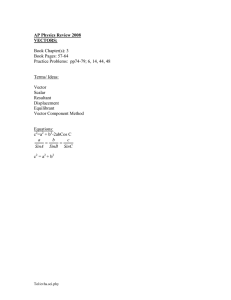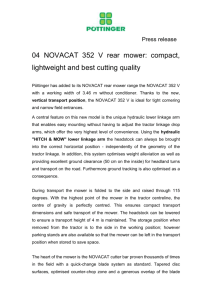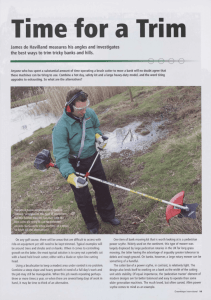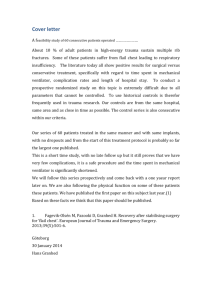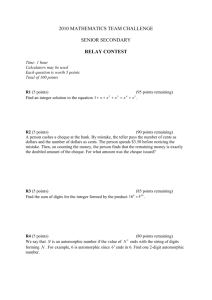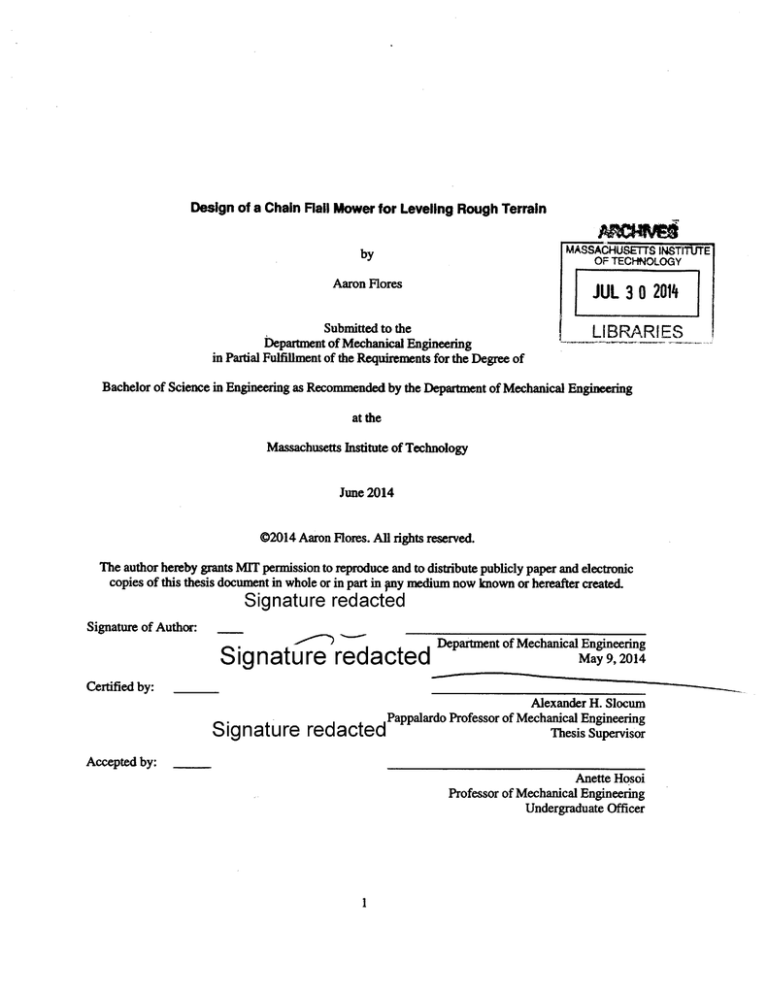
Design of a Chain Flail Mower for Leveling Rough Terrain
MASSACHUSETTS INSTITUTE
OF TECHNOLOGY
by
Aaron Flores
LiL 3
Submitted to the
Department of Mechanical Engineering
in Partial Fulfillment of the Requirements for the Degree of
..LI BRA R IES
Bachelor of Science in Engineering as Recommended by the Department of Mechanical Engineering
at the
Massachusetts Institute of Technology
June 2014
@2014 Aaron Flores. All rights reserved.
The author hereby grants MIT permission to reproduce and to distribute publicly paper and electronic
copies of this thesis document in whole or in part in pny medium now known or hereafter created.
Signature redacted
Signature of Author:
___
Signature redacted
Department of Mechanical Engineering
May 9, 2014
Certified by:
Signature redacted
Alexander H. Slocum
Pappalardo Professor of Mechanical Engineering
Thesis Supervisor
Accepted by:
Anette Hosoi
Professor of Mechanical Engineering
Undergraduate Officer
1
ES
2
Design of a Chain Flail Mower for Leveling Rough Terrain
by
Aaron Flores
Submitted to the Department of Mechanical Engineering
on May 9, 2014 in Partial Fulfillment of the Requirements for the Degree of
Bachelor of Science in Engineering as Recommended by the Department of Mechanical Engineering
Abstract
The flail mower is a piece of agricultural equipment that uses bladed attachments rotating around a drum
to cut down bushes and grassy terrain. One major drawback to the flail mower is the rapid wear that
happens almost immediately when any sort of rocks, gravel, or rough terrain are encountered. The goal of
this project was to design and manufacture a prototype of a machine that could level rough terrain through
repeating impacts as opposed to cutting with blades. The final design was a chain flail mower, a piece of
equipment designed to level rough terrain that uses chains to repeatedly bludgeon rocks, gravel, and
debris. The designed chain flail mower was assembled into an existing commercially available snow
blower for testing.
Thesis Supervisor: Alexander H. Slocum
Title: Pappalardo Professor of Mechanical Engineering
3
Acknowledgements
I would like to thank Professor Slocum for being a mentor to me the past couple of years.
Professor, you have helped me grow tremendously with your attitude, advice, and published books! I
would also like to thank Brandy Baker for her help and encouragement, Mark Belanger for his help, and
my Edgerton Center family for providing a space to work in and enough friends to last a lifetime. Next, I
would like to thank Josh Dittrich for the use of his shop, resources, and general friendliness and
willingness to help. Last, I would like to thank my fianc6 Sophie Foster-Fink for all of her
encouragement, all of the dinners she cooked for me when I was too busy to eat, all of the coffee she
made for me in the morning, and her love and understanding. Love you Sophie.
4
Table of Contents
Abstract ............................................... 6...........................*............................................................................. 3
Acknowledgm ents ....................................................................................................................................... 4
1. Introduction ............................................................................................................................................... 6
2. Design ....................................................................................................................................................... 7
3. Analysis .................................................................................................................................................... 9
3.1 Stress in the Chain and Shackle .......................................................................................................... 9
3.2 Stress in the Welds ............................................................. .............................................................. 10
4. Results .....................................................................................................................................................11
5. Conclusion ........................................... ............... ............................. .*...
... .......... ..................... .......... 12
6. References ........... o .......o ..................................................................0 ..... ....o ....... o ...................................... 13
5
1. Introduction
The goal of the project is to design a machine for leveling rough dirt terrain. The designed chain
flail mower machine is modeled after a flail mower, which is designed for leveling grass-filled terrain.
The flail mower (shown below) is a piece of agricultural equipment comprised of a rotating drum usually
driven by a hydraulic motor attached to a tractor. Welded to the drum are numerous free-floating "Y"
shaped blades with one degree of freedom usually attached by a bolt or pin. As the drum spins, the blades
cut down grass at very high speeds (around 6000 fpm) and are also able to absorb impact through their
bolted joint.
Figure 1: Image of a chain flail mower taken from httv://scsc302.wikisaaces.com/rile/view/flailiPPJ187565895/flaflic
The drawbacks of the flail mower are that the blades at the ends of the flail wear almost
immediately when they encounter rocks, dirt, or other sorts of rough terrain. Although these blades are
replaceable, the quick wearing makes cutting rough terrain impractical. Thus, flail mowers are more
effective for flat, grass-filled terrain and much less effective for uneven, rough, dirt-filled terrain.
Another source of inspiration for the chain flail mower is the mine flail pictured below. A mine
flail is a piece of landmine clearing equipment that is either built into specialized vehicles or attached to
6
the front of tanks by a boom. It is similar to the flail mower in that it has a rotating drum, but driven is by
different types of motors ranging such as electrical, hydraulic, or combustion. The mine flail has
numerous chains welded to the rotating drum and a large weight attached to the end of each chain. The
chain and weight assembly rotates at high speeds and triggers and detonates mines. The key feature in the
mine flail is the ability to handle rough terrain without the rapid wear of the flail mower because of the
bludgeoning effect of the chains.
Figure 2: Image of the MineWolf Landmine clearing vehicle from MineWolf Systems. Taken from
http://www.minewolf.com/products/medium-minewolf-mw330.html
2. Design
The primary functional requirement for the project was the ability to level rough, uneven terrain
including rocks, gravel, and grass. Using the flail mower and the mine flail as guides, the chain flail
mower uses chains attached to a cylindrical rod in order to create a bludgeoning effect for terrain and
debris removal and leveling as opposed to the cutting effect from the blades of the flail mower. The chain
flail mower uses four strips of steel welded on a steel cylindrical rod. The cylindrical rod has two
shoulders for ball bearings, and is driven on the snow blower through a machine key at the end of the
cylindrical rod. The chains are individually attached to holes drilled in the steel strips with a self-locking
7
shackle. The both sides of the rod have tapped holes drilled axially to constrain the rod within the
machine, in this case the snow blower.
The design of the chain flail mower is different from the flail mower in that it is not a hollow
drum, baut a solid rod because of the size difference in the equipment. The chain flail mower also features
long welded strips as opposed to tabs. This allows the flail joints to still have a single degree of freedom,
still remain in double shear so they don't have a bending moment, and be more cost-effective to
manufacture because of less welds and less machining time. In order to address terrain leveling, the
chains are placed as close together as possible with 0.100" clearance between them. They are then
staggered such that there is a sine-wave effect that pushes terrain to one side when the cylindrical rod
rotates. The staggering can be changed such that terrain is pushed out, pushed in, or to one side. Because
the chains are much closer together than the chains in the mine flail, the amount of terrain leveling is
greater for the chain flail mower than the mine flail.
Figure 3: Self-locking shackle. Taken from http://cdn3.volusion.com/uybnd.syfpy/v/vspfiles/photos/WIC1202-2.jpg
8
Figure 4: Solidworks CAD model of the chain flail mower with one chain attached
3. Analysis
The mechanical design of the chain flail mower was driven by the theory that the lifecycle of a
stressed system is approximately infinite when the system's material is steel and the stress it experiences
is less than 50% of its maximum yield stress', or that the factor of safety had to be greater than 2. Since
the chain flail mower was designed to a commercially available snow blower, the stresses in the bearings
and the key were assumed to be safely within the limits of failure.
3.1 Stress in the Chain and Shackle
The chains and shackles were modeled as a single point mass for an upper bound, first-order
approximation of the stress. The equation describing a point mass in circular motion is given as:
Fnet = Fc = M r
(1)
Where Fnet is the net force on the system, F is the centripetal force, m is the mass of each chain
and shackle, v is the tangential speed, and r is the radius to the center of gravity along the length of the
chain. The total mass of the chain and shackle assembly was used as the point mass for a worst-case
scenario approach to the stress analysis. Substituting the equation 2 for angular velocity w in revolutions
per minute (rpm) and rearranging gives equation 3:
=6r
9
(2)
FC = m
(' r-602
(3)
The stress was assumed to be linearly proportional to the force such that 50% of the yield stress
oY meant 50% of the maximum force shown in equation 2:
(4)
Fc ~ cy
What this shows is that the yield stress is directly proportional to the square of the rotational velocity of
the cylindrical rod, such that as the drum rotates faster the stress will be higher.
3.2 Stress in the Welds
The welded strips were analyzed as having a fillet weld on both sides subjected to a shear force as
shown below:
2
Figure 5: Diagram of a welded steel beam in bending using outside fillet welds
Total stress rtotaI on the weld joint was calculated 2 using equation 5:
Ttotal=
Where
Tb
Tb + Ts
(5)
is the stress due to bending and Tr is the stress due to shear. The bending and shear stresses
were calculated 2 using equations 6, 7, 8.
x = (d + 2h) 3 - d 3
Tb
8.5PA(d+2h)
10
(6)
(7)
Ts =
0.71P
i(
(8)
Where P is the load, b is the width of the beam, d is the depth of the beam, h is the thickness of the welds,
and A is the area of the beam as shown in Fig. 5 above. The main disadvantage with this welded design
over the flail mower is bending stress along the weak axis of the strips as opposed along the stiffest axis
in the tabs on a conventional flail mower. This is mitigated by having a short bend radius and using a
sufficient thickness for the strip.
4. Results
The original goal of the project was to develop a piece of agricultural equipment capable of
leveling rough terrain including dirt and debris. A prototype chain flail motor was manufactured to fit the
dimensions of a Toro snow blower3 and installed as shown below.
Figure 6: Detailed view of one end of the final manufactured chain flail mower
11
Figure 7: The designed chain flail mower prototype instb
The manufactured chain flail mower shown is welded on both sides along the entire length of the
strip. The shackles have a workload limit of 700lbs-f while the chain has a workload limit of 400lbs-f.
Using equation (1), the maximum surface speed that the mower can use while still under the limiting
workload limit is 6600 fpm.
Weld strength is more difficult to analyze since measured strengths are always less than
theoretical due to external factors such as weld penetration and annealing. The yield stress for the welds
on the chain flail mower was estimated to be much less than the 50% yield criteria.
5. Conclusion
The chain flail mower uses chains with weights attached at the end of a chain in order to create a
bludgeoning effect for terrain and debris removal and leveling as opposed to the cutting effect from the
blades of the flail mower. The mower vehicle was manufactured and installed by replacing the auger of a
snow blower with the finished design. The vehicle was not tested, and would need various safety
precautions such as a safety shield to prevent injury from flying projectiles. Testing would need a way to
12
quantify the terrain leveling ability and comparing it to the leveling abilities of commercially available
products flail mowers and mine flails. For commercial use, the chain flail mower would need to be scaled
higher and would be powered through a hydraulic motor or an attachment to an existing drivetrain. Weld
testing should be result in a reduction in the amount of weld beads needed for stich welds. Similarly, bolts
or different shackles with vibration resistant fasteners should be used to withstand repeated impacts and
would need thread-locking adhesive for maximum safety. Additionally, bushings would ideally be
assembled in the joints connecting the chain to the rotating cylinder or drum to prevent wear on the joint.
Last, more comprehensive analysis needs to be performed on the dynamics of repeated impacts on chains
for a finer characterization of the yield stresses.
13
6. References
'Shigley, Joseph Edward, Charles R. Mischke, and Richard G. Budynas. MechanicalEngineeringDesign.
New York, NY: McGraw-Hill, 2004
2Beardmore,
R. Taken from http:I/www.roynech.co.ukflseful TableslForm/Weld strength.html. 25
April 2014
3
Operator'sManual. Form no. 3369-487 Rev B. Bloomington, MN: The Toro Company, 2011
14

